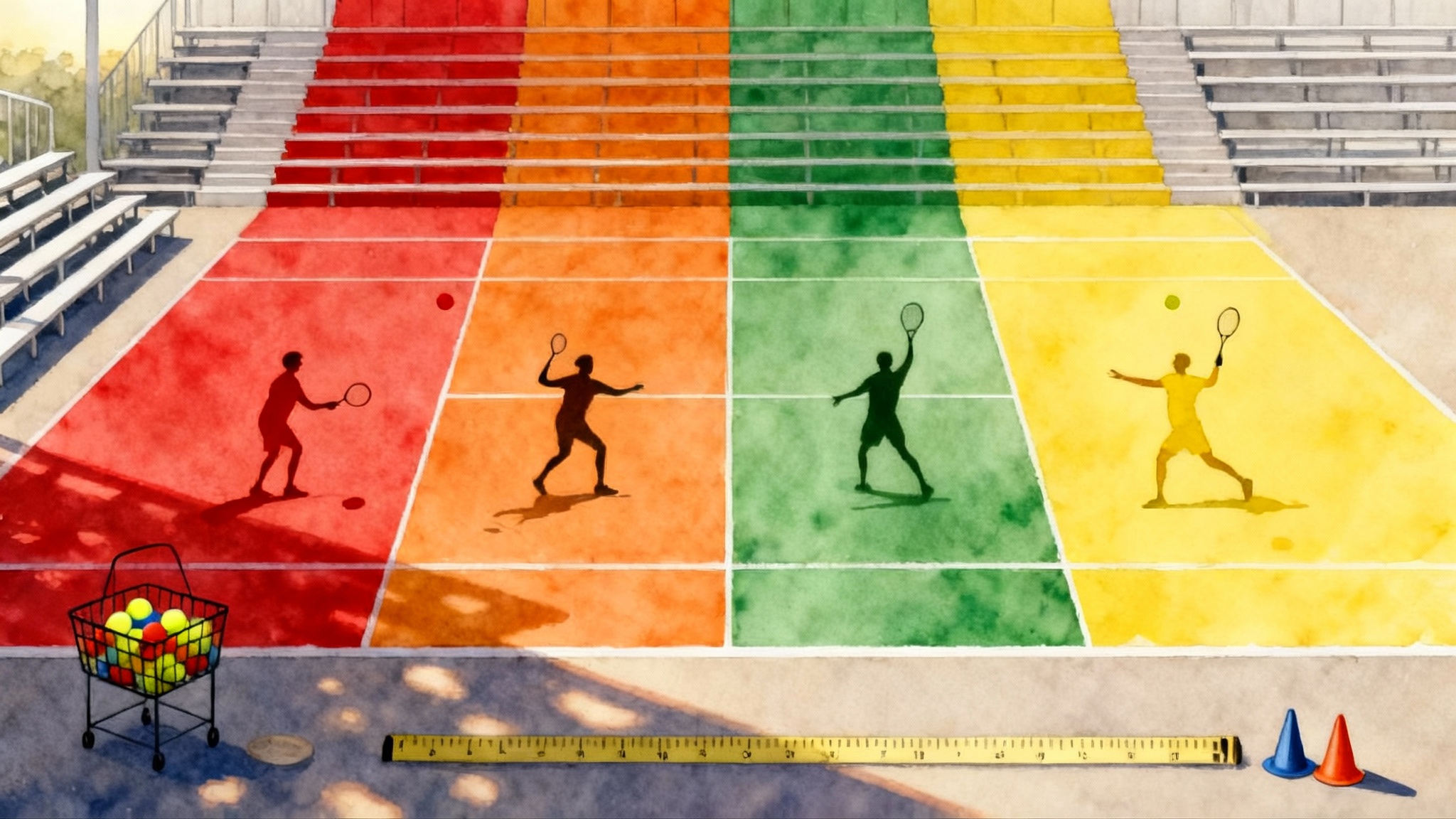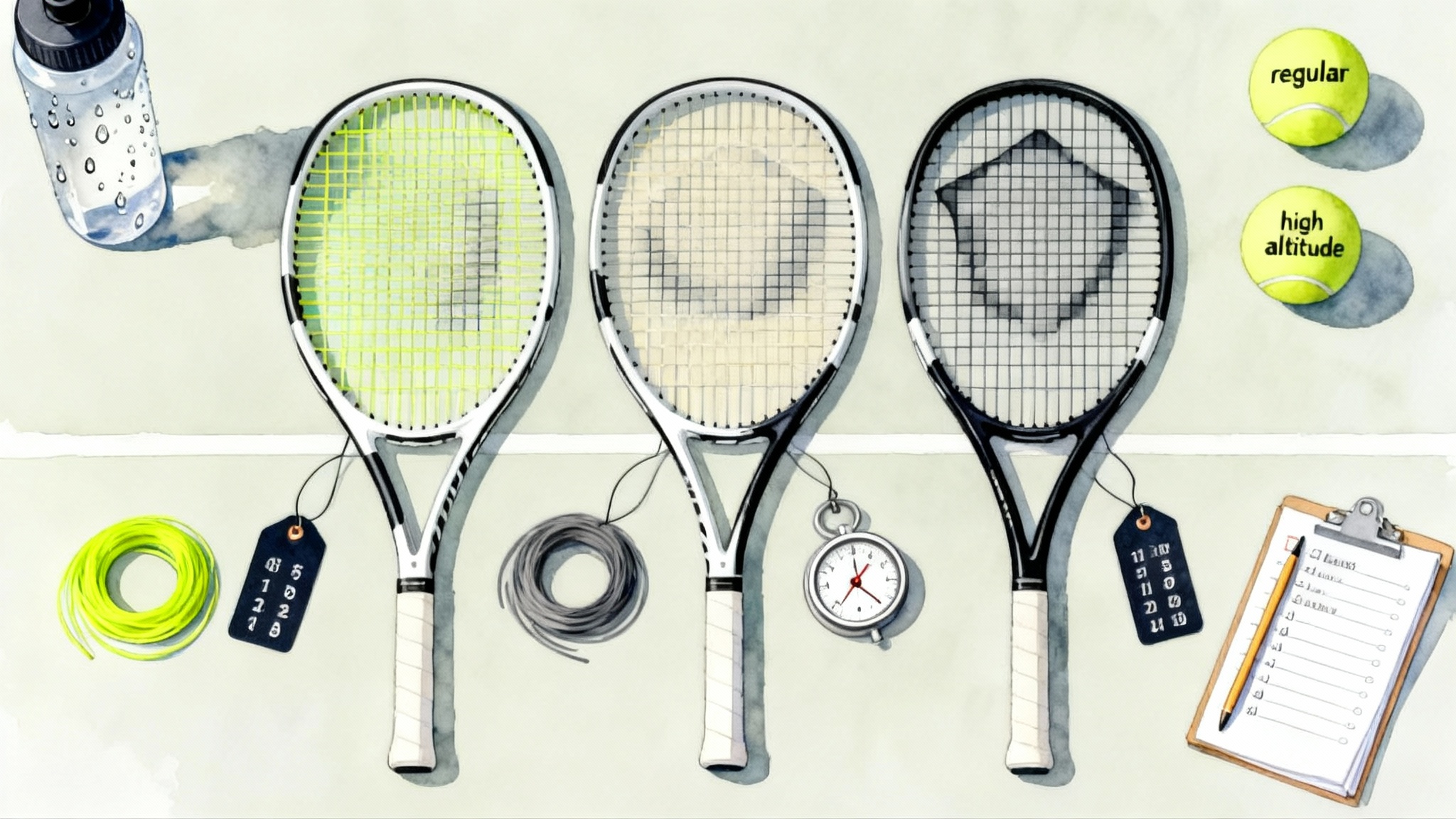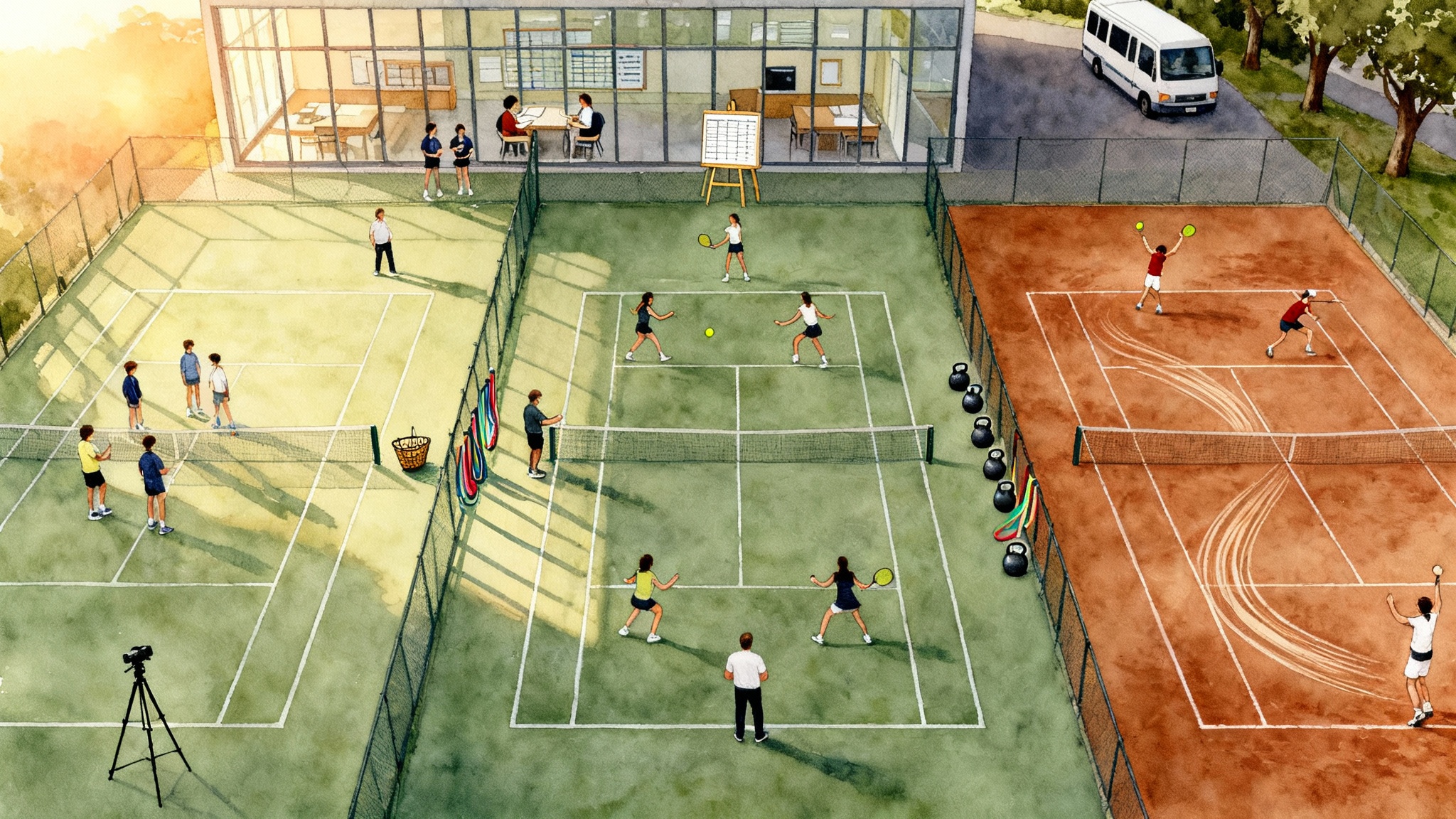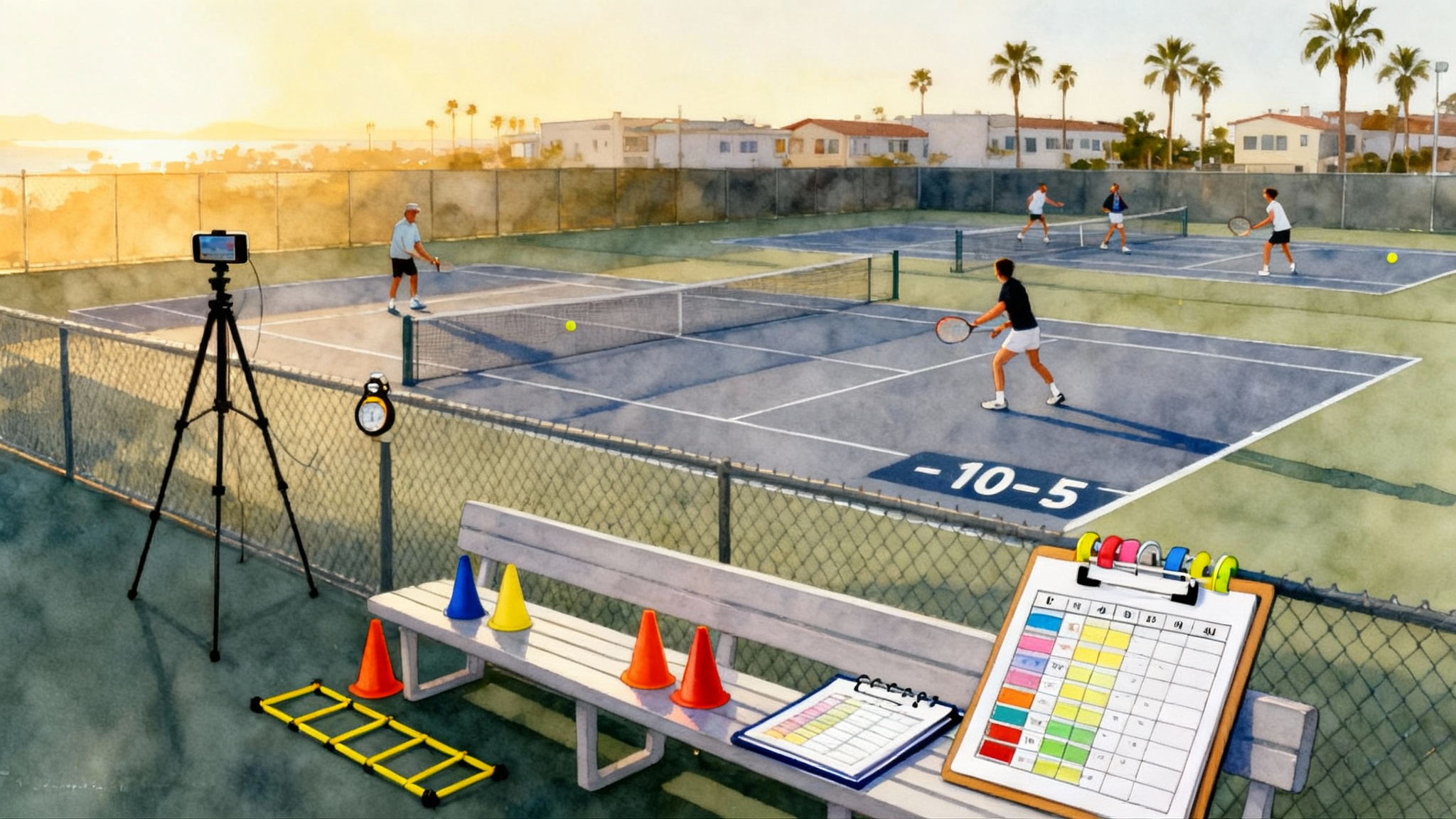2025 Tennis Weekly Blueprints for Juniors and Adult 3.0-4.5
Clear, printable weekly plans for 10U, 12-14U, 15-18U college hopefuls, and adult 3.0-4.5 players. Learn readiness tests, volume caps, and how to adjust for exams or work. Includes recruiting and pro pathway notes.

Why weekly blueprints matter in 2025
A good week on paper usually becomes a better week on court. Weekly plans turn intentions into repeatable habits, keeping training balanced across skill, speed, strength, mobility, and recovery. That balance reduces injury risk, builds confidence, and converts practice into wins. For families and busy adults, a clear template also removes the planning stress that eats time and energy.
This guide gives you age- and level-specific blueprints you can copy today. You will see daily dose targets, simple readiness checks, and exact rules for scaling up or down when life crowds the calendar. We also map the moments when juniors should start showcases, how to build a simple recruiting portfolio, and the first realistic steps toward ATP and WTA qualifying events.
How to use this guide
- Start with the readiness tests and volume caps. These guardrails keep progress steady and sustainable.
- Pick the weekly plan for your group. Treat it like a recipe. Follow it for 6 to 12 weeks before changing the main ingredients.
- Use the adjustment rules whenever exams or work deadlines hit. Consistency beats perfection.
- Download the printable planner to track sessions, sleep, and soreness: 2025 weekly planner templates.
Readiness tests and volume caps
Training only works if the body is ready to absorb it. Use these quick checks before the first session of the week. Record results in your planner.
Universal readiness checks
- Morning energy score: 1 to 5. Aim for 3 or higher before hard sessions.
- Resting pulse: if it is up 7 beats per minute from your normal baseline, reduce volume by 20 percent for two days.
- Jump test: three countermovement jumps, best height or best hang time. If your best is down more than 10 percent from last week, keep intensity moderate for 48 hours.
If two of the three checks are off, treat the week as a maintenance week.
Youth-specific screens
- Single-leg balance: eyes open, hands on hips. 10U aim for 15 seconds each leg. 12-14U aim for 20 seconds. 15-18U aim for 25 seconds. If you miss the target, reduce change-of-direction sprints that week and add two short balance blocks after practice.
- Plank hold: 10U aim for 45 seconds. 12-14U aim for 75 seconds. 15-18U aim for 90 seconds. If you fall short, cut one heavy strength set and add two mobility circuits.
Volume caps by group
These caps include practice, match play, strength, and conditioning.
- 10U: 4 to 6 total hours per week. No more than 2 days in a row of on-court sessions. Max 600 serves in a week. Max 40 minutes total of high-speed running.
- 12-14U: 6 to 9 total hours per week. One full rest day minimum. Max 900 serves. Max 70 minutes total of high-speed running.
- 15-18U and college hopefuls: 9 to 14 total hours per week in base periods. Tournament weeks may hit 16 hours, but only for one week out of three. Max 1,200 serves. Max 100 minutes total of high-speed running.
- Adult 3.0-4.5: 5 to 8 total hours per week. At least 1 complete day off. Max 800 serves. Max 60 minutes total of high-speed running.
High-speed running means sprints faster than your 1-mile race pace. If you track with a wearable, tag sessions where you are above 85 percent of your best 1-mile speed. If you do not use a device, treat any sprint longer than 3 seconds at max effort as high-speed.
The weekly blueprints
Each plan blends technical work with speed, strength, mobility, and recovery. Session intensity uses the rate of perceived exertion scale from 1 to 10, where 10 feels like an all-out test. Pair technical days with the First Four Shots playbook to convert more service and return games.
10U weekly plan
Focus: playful skill variety, contact point consistency, safe speed, and fun.
- Monday: 45 minutes skills and games at RPE 6. Targets, ladder games, drop-feed forehand and backhand. Finish with 10 minutes of tag or short relays.
- Tuesday: 20 minutes home coordination. Sock throws to targets, skipping patterns, single-leg balance with eyes looking side to side.
- Wednesday: 45 minutes on-court at RPE 6. Serve toss and contact, red or orange ball rallies, mini-sets to 7. Finish with 5 minutes mobility: ankle rocks, cat-camel, shoulder circles.
- Thursday: Off or light play in the backyard. Optional 15 minutes of wall hits.
- Friday: 45 minutes on-court at RPE 7. Crosscourt consistency game to 11, approach and volley stations, serve challenge to cones. End with 5 minutes of diaphragmatic breathing.
- Saturday: Family play day. 30 minutes easy rallying and cooperative targets. No score focus.
- Sunday: Full rest.
Dosage notes: keep throws and overheads playful. Use red or orange balls to control speed. If the jump test drops this week, replace Friday with a scavenger hunt on court and a long cooldown walk.
Download: 10U one-page schedule.
12-14U weekly plan
Focus: footwork patterns, repeatable serve, and strong movement skills.
- Monday: 75 minutes on-court at RPE 7. Forehand and backhand shape, depth ladder, serve rhythm. Finish with 10 minutes of medicine ball throws. If you lack equipment, use a light backpack with a towel inside.
- Tuesday: 35 minutes strength and mobility. Split squat 3 sets of 6 per side, hip hinge 3 sets of 6, push-up 3 sets to a solid form standard, plank 2 sets of 45 seconds. Mobility finisher: world’s greatest stretch, couch stretch, thoracic rotations.
- Wednesday: 60 minutes on-court at RPE 6. Pattern building. Serve plus one, return plus one, approach and first volley. End with 8 by 10 meter accelerations, walk back recovery.
- Thursday: Rest or study focus day. Optional 20 minutes of easy wall hits.
- Friday: 75 minutes on-court at RPE 8. Live points in half court, serve targets, tiebreaker to 7. Breathing and downregulation for 5 minutes.
- Saturday: 45 minutes conditioning at RPE 7. 6 repeats of 20 seconds on and 70 seconds off shuttle runs. Then 10 minutes of mobility.
- Sunday: Rest.
Adjustment: if school load spikes, convert Friday to 45 minutes technical only, no live points. Keep Saturday as a brisk walk and mobility.
Download: 12-14U one-page schedule.
15-18U and college-hopeful weekly plan
Focus: weapon development, repeatable patterns under fatigue, and decision speed.
- Monday: 90 minutes on-court at RPE 7. Serve plus forehand, backhand line change, return depth challenge. Finish with 12 minutes of mobility.
- Tuesday: 50 minutes strength. Lower body and trunk focus. Trap bar or kettlebell deadlift 4 sets of 4 at a weight that feels like RPE 7. Front foot elevated split squat 3 sets of 6 each side. Half-kneeling cable or band press 3 sets of 8. Side plank 2 sets of 45 seconds each side.
- Wednesday: 75 minutes on-court at RPE 8. Pattern play with constraints. First strike to backhand corner, finish to open space. 12 by 8 meter accelerations with change of direction. Cooldown and breath work.
- Thursday: Rest or video review. Watch 15 minutes of your last match and tag three points you would replay with a different choice.
- Friday: 90 minutes on-court at RPE 8 to 9. Serve targets, return patterns, 2 out of 3 sets of 4-game practice sets starting at 30-all. Mental skill: reset routine between points.
- Saturday: 50 minutes strength and speed. Superset rear-foot elevated split squat 3 by 5 per side with broad jumps 3 by 3. Finish with 8 by 10 second hill sprints, walk back.
- Sunday: Rest.
Tournament week edit: cut Tuesday strength to 30 minutes light, skip Saturday speed, and reduce Friday to RPE 7 with short point play. Keep mobility daily.
College showcase and recruiting notes:
- When to add showcases: if you are 15 or older and competing weekly with success at your current section level, place two showcases in the next 6 months. Schedule them outside exam weeks.
- What to bring: a one-page player resume with recent results, short goals, and coach contact. A 3 to 5 minute skills and points video posted on your cloud drive.
- What coaches care about: movement, shot tolerance at neutral, serve speed relative to peers, and how you respond to pressure. Learn the junior competitive pathway language so you can explain your level clearly. The USTA junior pathway overview organizes divisions and formats for the United States.
For a full planning calendar, use this month-by-month college pathway.
Simple recruiting portfolio checklist:
- Contact header with city, graduation year, and academic interests.
- Best match clips with score overlay and 2 or 3 full games unedited.
- Two coach references with email and phone.
- Fitness snapshot: sprint time to 20 meters, 505 change of direction in seconds, plank time, and best vertical jump.
- Training week example taken from this plan.
Download: 15-18U one-page schedule.
Adult 3.0-4.5 weekly plan
Focus: efficient practice that fits a real work week. Emphasis on serve, return, and first two balls, with recovery that protects the shoulder, back, and knees.
- Monday: 60 minutes on-court at RPE 7. Serve targets to 4 quadrants, return blocks crosscourt, plus 15 minutes of pattern drilling serve plus one.
- Tuesday: 35 minutes strength and mobility. Hip hinge 3 by 6, split squat 3 by 6 per side, incline push-up 3 by 8, band rows 3 by 10, finish with hamstring flossing and thoracic rotations.
- Wednesday: 60 minutes doubles or live points at RPE 8. Work first volley depth, poach timing, and return position. Stop at 60 minutes even if you feel fresh.
- Thursday: Off or 20 minutes mobility and a 25 minute walk.
- Friday: 45 minutes serve and return at RPE 6. Groove without chasing speed.
- Saturday: Match play 90 minutes max. If league, use your match. If not, play two short sets to 4 with no ad.
- Sunday: Rest.
Busy week edit: if work peaks, keep only Tuesday strength and a single 45 minute serve plus return session. Maintain sleep and mobility.
Download: Adult 3.0-4.5 one-page schedule.
Adjustment rules for exams or busy work weeks
- Two-for-one rule: for every high-stress day outside tennis, remove one planned high-intensity block and replace it with 20 to 30 minutes of technique and mobility.
- Red-yellow-green days: red equals poor sleep or two failed readiness checks. Reduce volume by 40 percent and skip sprints. Yellow equals one failed check. Reduce volume by 20 percent and keep intensity moderate. Green equals all clear.
- Minimum effective dose kit: if you only have 30 minutes, do 10 minutes of serve targets, 10 minutes of return blocks, and 10 minutes of mobility. It keeps your touch and your shoulder happy.
Spotlight: sample weeks from Tustin Tennis Academy
If you train in Orange County, Tustin Tennis Academy runs structured group sessions that map to these blueprints.
Sample weeks they often use:
- 12-14U skills ladder: Monday ball-strike consistency, Wednesday pattern building with live feeds, Friday serve plus return games, Saturday conditioning and movement. Two coaches track rally length goals and serve targets.
- 15-18U point pressures: Monday pattern building, Wednesday live points in situational games, Friday short practice sets with simulated pressure starts, Saturday strength and speed in small groups.
- Adult 3.5 strategy lab: Monday doubles formations and first volley depth, Wednesday return patterns and poach timing, Saturday match play blocks to 4 games with quick turnarounds.
Pathway notes: showcases, recruiting, and first pro steps
Showcases for juniors: two events per year starting at age 15 is plenty if you are also playing regular tournaments. If travel is tight, target the closest regional showcase and coordinate with your school calendar. Send coaches your one-page portfolio one week before, and send a short thank you plus one match clip within 72 hours after.
College recruiting timelines by grade:
- Sophomore fall: build your portfolio, collect two match videos, and track competition goals.
- Junior year: two showcases spaced by three months, update your portfolio once each quarter, and schedule two unofficial campus visits if possible.
- Senior fall: narrow your list, confirm academic fit, and keep match play steady with reduced volume the week of visits.
First steps toward ATP or WTA qualifying events:
- Understand the pathway: many players begin in International Tennis Federation 15K and 25K events, then climb toward Challenger and Tour level. Read the ITF World Tennis Tour entry process to learn rankings, entries, and how qualifying draws work.
- Create your player profile and manage entries. Keep a calendar of sign-in deadlines and travel windows. Build a two-tournament swing each trip to double your match exposure.
- Performance standards before you go: hold serve at least 70 percent in local Open-level play, win more than half your return games at your section level, and maintain a 90 minute practice set at RPE 8 without a drop in hitting quality. If you cannot hit those marks consistently, you gain more value from another 12 weeks on the college or high-level junior circuit before trying pro qualifying.
Budget and recovery for early pro trips:
- Plan for two weeks per swing with two qualifying attempts. Budget for flights, local transport, meals, and stringing. Pack two pairs of shoes and a dedicated recovery kit that includes a jump rope, mini bands, and a lacrosse ball.
- After travel days, your first session should be a 30 minute mobility and rhythm hit, not a hard practice set. Save the hard set for day two.
Practical cues for skill blocks
Use these one-line cues during sessions. They are simple to remember under pressure.
- Serve: lift the ball with a loose hand, throw the racquet head up early, finish with a full shoulder turn.
- Return: small split as the server tosses, short backswing, lean through contact.
- Rally tolerance: breathe out on contact, drive your legs through the shot, aim three feet above the net until you have space.
- First volley: see the ball bounce through the strings, step through with the opposite foot, place it deep middle first.
Recovery that players actually do
Recovery that fits into the day gets done. These are short and effective.
- Three-minute shower contrast: 30 seconds cool, 30 seconds warm, repeat three times.
- Five-minute floor flow: cat-camel, half-kneeling hip flexor, thoracic open book, ankle rocks, repeat.
- Two-minute breath reset: inhale 4 seconds, exhale 6 seconds for 12 rounds.
What to track weekly
- Serve targets made out of 20 to each corner.
- Best of three jumps and your resting pulse.
- RPE after the hardest session and how long it took to feel normal again.
- One match clip that shows a pattern you planned to use.
Tracking makes progress visible. When the numbers stall, scale back volume for seven days and tighten your technical focus. When the numbers climb, lock in your routine and ride the wave.
Your next step
Pick the plan for your group, download the one-pager, and commit to six weeks. If you want coached structure, explore the options at Tustin Tennis Academy. If not, share the plan with a partner and set a weekly check-in. Good tennis grows from good weeks, and good weeks are built with simple, specific choices repeated over time.






